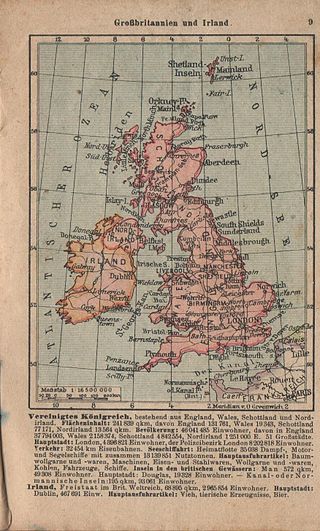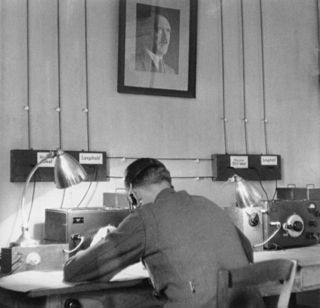
Plan Kathleen, sometimes referred to as the Artus Plan, was a military plan for the invasion of Northern Ireland by Nazi Germany, sanctioned in 1940 by Stephen Hayes, Acting Irish Republican Army (IRA) Chief of Staff.

Operation Green often also referred to as Case Green or Plan Green, was a full-scale operations plan for a Nazi German invasion of Ireland planned by an unknown German officer known by the alias "Hadel" in support of Operation Sea Lion, the invasion of the United Kingdom, during World War II. Despite its detailed nature, Operation Green is thought to have been designed only as a credible threat, a feint, not an actual operation. Plan W, a planned occupation of all of the Free State by the British Armed Forces, was drafted by the British military in secret liaison with the Irish government to counteract any German invasion.
Marlag und Milag Nord was a Second World War German prisoner-of-war camp complex for men of the British and Canadian Merchant Navy and Royal Navy. It was located around the village of Westertimke, about 30 km (19 mi) north-east of Bremen, though in some sources the camp's location is given as Tarmstedt, a larger village about 4 km (2.5 mi) to the west. There were also American merchant seamen detained here as well as some U.S. Navy personnel.

Frank Ryan was an Irish politician, journalist, intelligence agent and paramilitary activist. He first came to prominence as an Irish republican activist at University College Dublin and fought for the Irish Republican Army during the Irish Civil War. Ryan fell under the influence of Peadar O'Donnell, an advocate of socialism within Irish republicanism, which resulted in him breaking with the IRA and becoming involved with founding a new political organisation, the Republican Congress, and editing its associated newspaper, An Phoblacht.
Operation Seagull was an Abwehr II/Brandenburger Regiment-sanctioned mission launched in September 1940. The object of the mission was to infiltrate the UK in preparation for Operation Sea Lion.
Operation Seagull I was an Abwehr II sanctioned mission devised in May 1942. The plan was the brainchild of Kurt Haller and an expert from Abwehr I-Wi (economic). The plan envisioned the use of an Abwehr agent to sabotage the North Scottish power station at Fort William.
Operation Seagull II was an Abwehr II. sanctioned mission planned in June 1942 as a refinement of Operation Seagull I. The plan envisioned in Seagull II was to use an Irish Abwehr agent ("V-Manner"), who would parachute into the area of south-east of Ballycastle in Northern Ireland, recruit a sabotage team from any willing IRA personnel in the area, and attack important "targets of opportunity" in the immediate vicinity. Both operations were to be controlled by radio and with each sabotage team in Ireland and Scotland liaising with each other via radio contact.
Operation Osprey was a plan conceived by the German Foreign Ministry and Abwehr II. mid-1942. The plan was an enlargement of Operation Whale. Planning took place in the context of American troops landing in Northern Ireland 26 January 1942, and Hitler's immediate fears surrounding this.

The "Irish Brigade" was an attempt by Sir Roger Casement to form an Irish nationalist military unit during World War I among Irishmen who had served in the British Army and had become prisoners of war (POWs) in Germany. Casement sought to send a well-equipped and well-organised Irish unit to Ireland, to fight against Britain, in the aim of achieving independence for Ireland. Such an action was to be concurrent with the ongoing war between Britain and Germany, thereby providing indirect aid to the German cause, without the ex-POWs fighting in the Imperial Germany Army itself.
John Codd was an Irish-born British Army corporal during World War II, who went on to serve in the German Intelligence service (Abwehr) and the Sicherheitsdienst, the foreign intelligence arm of the SS.
The Irish Republican Army (IRA), a paramilitary group seeking to remove Northern Ireland from the United Kingdom and unify Ireland, shared intelligence with the Abwehr, the military intelligence service of Nazi Germany, during the Second World War.
Operation Whale was the name of two separate German Intelligence (Abwehr) plans conceived in 1940.
Operation Innkeeper was an aborted plan devised in Autumn 1941 to send two Irish Abwehr agents to London on a sabotage mission.
Günther Schütz was a German citizen who worked for German Intelligence (Abwehr) during World War II, he was deployed to Ireland, however, after parachuting to the wrong location he was apprehended by Irish police, and spent much of the rest of the war in prison, barring a brief escape.
James Brady was one of two Irishmen known to have served in the Waffen-SS during World War II.
Sonderlehrgang z.b.V. "Oranienburg" was a commando and special forces unit of Nazi Germany's SS. It was assembled in early 1942 on the order of SS-Obergruppenführer Hans Jüttner as a rival to the Heer's Brandenburg Regiment.

The Abwehr was the German military-intelligence service for the Reichswehr and the Wehrmacht from 1920 to 1945. Although the 1919 Treaty of Versailles prohibited the Weimar Republic from establishing an intelligence organization of their own, they formed an espionage group in 1920 within the Ministry of Defence, calling it the Abwehr. The initial purpose of the Abwehr was defense against foreign espionage: an organizational role that later evolved considerably. Under General Kurt von Schleicher the individual military services' intelligence units were combined and, in 1929, centralized under Schleicher's Ministeramt within the Ministry of Defence, forming the foundation for the more commonly understood manifestation of the Abwehr.
Stalag III-D was a World War II German Army prisoner-of-war camp located in Berlin.
Operation Zeppelin was a top secret German plan to recruit Soviet prisoners of war (POWs) for espionage and sabotage operations behind the Russian front line during World War II. Active from mid-1942 to the end of the war in spring 1945, the operation initially intended to send masses of agents to Soviet Russia to collect military intelligence and to counterbalance sabotage activities carried out by the Soviet partisans. To that end, Germans recruited thousands of Soviet POWs and trained them in special camps. However, this approach had to be abandoned in favor of more targeted operations due to a lack of reliable Soviet recruits and dwindling resources, such as aircraft fuel. Operation Zeppelin was particularly important for intelligence gathering in the Eastern Front, but its more ambitious missions yielded little results. It had some success in the Caucasus where the various peoples of the Caucasus aspired to become independent from the Soviet Union, but other missions, such as sabotage of power plants near Moscow or a plot to assassinate Joseph Stalin, were abandoned or failed. A particular failure was the desertion of the Brigade SS Druzhina in August 1943.

Oscar Carl Pfaus was a German immigrant who became an American citizen through military service. He had a succession of jobs before becoming involved in pro-Nazi organizations in Chicago in the early 1930s and becoming a full-time Nazi propagandist there. He was also active in New York.






